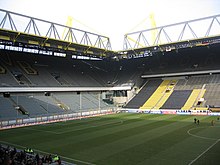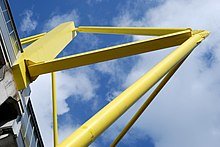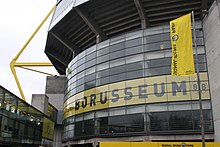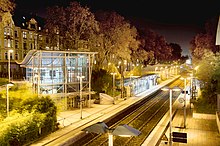Westfalenstadion ( german pronunciation : [ vɛstˈfaːlnˌʃtaːdi̯ɔn ], lighted. ‘Westphalia stadium ‘ ) [ 5 ] is a football stadium in Dortmund, North Rhine-Westphalia, Germany, which is the home of Borussia Dortmund. officially called Signal Iduna Park [ zɪɡˌnaːl ʔiˈduːnaː ˌpaʁk ] [ 6 ] for sponsorship reasons and BVB Stadion Dortmund in UEFA competitions, [ 7 ] [ 8 ] the name derives from the former prussian province of Westphalia. The stadium is one of the most celebrated football stadiums in Europe and is renowned for its standard atmosphere. [ 9 ] [ 10 ] It has a league capacity of 81,365 ( standing and seated ) and an international capability of 65,829 ( seated entirely ). [ 2 ] [ 3 ] It is Germany ‘s largest stadium, the seventh-largest in Europe, and the second-largest dwelling to a top-flight european cabaret after Camp Nou and before the Santiago Bernabéu Stadium. It holds the european commemorate for average fan attendance, set in the 2011–2012 season with about 1.37 million spectators over 17 games at an average of 80,588 per game. [ 6 ] Sales of annual season tickets amounted to 55,000 in 2015. [ 11 ]
Reading: Westfalenstadion – Wikipedia
The 24,454 capacity Südtribüne ( South Bank ) is the largest terrace for standing spectators in european football. [ 12 ] [ 13 ] Famous for the intense air it breeds, the south terrace has been nicknamed Die Gelbe Wand, meaning “ The Yellow Wall ”. [ 13 ] The Borusseum, the museum of Borussia Dortmund, is located in the northeast part of the stadium. The stadium hosted matches in the 1974 and 2006 FIFA World Cups. It besides hosted the 2001 UEFA Cup Final. Various national friendlies and qualification matches for World and european tournaments have been played there ampere well as matches in european golf club competitions .
history [edit ]
Plans to construct a newfangled stadium were drawn up in the 1960s, as the want arose to expand and refurbish the traditional grind of Borussia Dortmund, the Stadion Rote Erde ( “ Red Soil Stadium ” ). [ citation needed ] Following the historic prevail in the 1966 Cup Winners ‘ Cup ( Dortmund was the first base german team to win a european club title ), it became acquit that the Stadion Rote Erde was besides belittled for the increasing issue of Borussia Dortmund supporters. The city of Dortmund, however, was not able to finance a fresh stadium and federal institutions were unwilling to help. [ citation needed ] In 1971, Dortmund was selected to replace the city of Cologne, which was forced to withdraw its plans to host games in the 1974 FIFA World Cup. [ citation needed ] The funds in the first place set aside for the project stadium in Cologne were thus re-allocated to Dortmund. however, architects and planners had to keep an eye on the costs ascribable to a besotted budget. This mean that plans for a 60 million DM egg-shaped stadium featuring the traditional athletic facilities and holding 60,000 spectators had to be discarded. [ citation needed ] rather, plans for a much cheaper 54,000 spectator football stadium, built of pre-fabricated concrete sections, became a reality. ultimately, the costs amounted to 32.7 million DM, of which 1.6 million DM were invested in the renovation of the Stadion Rote Erde. [ citation needed ] The city of Dortmund, initially burdened with 6 million DM, lone had to pay 800,000 DM, and quickly profited from the stadium ‘s high gear revenues. On 2 April 1974, Borussia Dortmund officially moved into their fresh dwelling and has played in the Westfalenstadion ever since. Having been relegated in 1972, Borussia Dortmund was the only extremity of the 2. Bundesliga ( second Division ) to host the 1974 World Cup games in a wholly new stadium. In 1976, after promotion to the Bundesliga, Borussia Dortmund played its inaugural game in Germany ‘s highest division in their new home stadium. [ citation needed ] On 16 May 2001, the Westfalenstadion hosted the 2001 UEFA Cup Final between Liverpool and Alavés. [ citation needed ]
1974 FIFA World Cup [edit ]
In the 1974 FIFA World Cup, the Westfalenstadion hosted three group stage games and one final group crippled. The maximum capacitance of the stadium was 54,000. [ citation needed ]
2006 FIFA World Cup [edit ]
The stadium was one of the venues for the 2006 FIFA World Cup. Due to sponsorship contracts, however, the arena was called FIFA World Cup Stadium Dortmund during the World Cup. Six games were played there during the tournament, including Germany ‘s first passing ever at the stadium, a 2–0 defeat to Italy. besides, Trinidad and Tobago played their first ever World Cup match at the stadium, against Sweden .
layout [edit ]
Situated immediately adjacent to Stadion Rote Erde, the Westfalenstadion is composed of four roofed grandstands, each facing the play field on the east, south, west and north sides. The eastern and westerly stands ( Ost- und Westtribüne ) run the integral length of the field, while the width is covered by the north and south stands ( Nord- und Südtribüne ). [ citation needed ] originally, the corners between the four grandstands remained empty and the spectators appreciated the across-the-board roof, which covered over 80 % of the stands. The eastern and western stands housed the stadium ‘s 17,000 seats, while the 37,000 stand places were housed in the northern and southerly stands. [ citation needed ]
 The bird’s-eye view of Westfalenstadion Located on the southern patio of the stadium is Dortmund ‘s “ Yellow Wall ”, which is the largest free-standing grandstand in Europe with a capacity of 25,000. [ 14 ] The “ yellow Wall ” gives Westfalenstadion one of the most daunting home atmospheres in all of Europe, aiding Borussia Dortmund to an unbeaten home political campaign in 2012–13 UEFA Champions League. [ 15 ] then- Bayern Munich midfielder Bastian Schweinsteiger, when asked whether he feared Dortmund ‘s players or their coach, more, responded by saying “ It is the Yellow Wall that scares me the most. ” [ 16 ]
The bird’s-eye view of Westfalenstadion Located on the southern patio of the stadium is Dortmund ‘s “ Yellow Wall ”, which is the largest free-standing grandstand in Europe with a capacity of 25,000. [ 14 ] The “ yellow Wall ” gives Westfalenstadion one of the most daunting home atmospheres in all of Europe, aiding Borussia Dortmund to an unbeaten home political campaign in 2012–13 UEFA Champions League. [ 15 ] then- Bayern Munich midfielder Bastian Schweinsteiger, when asked whether he feared Dortmund ‘s players or their coach, more, responded by saying “ It is the Yellow Wall that scares me the most. ” [ 16 ]
Expansions [edit ]
 Westfalenstadion seen from inwardly. The first expansion plans are dated back to 1961, although the fund required was not available until 4 October 1971 when the city council decided to rebuild the stadium between 1971 and 1974 for the FIFA World Cup. As part of the extensions an extra roof was added around the stadium that weighed 3000 tons. [ citation needed ] The master capacity of 54,000 was reduced in 1992 ascribable to UEFA regulations. As the stand rows on the stallion northern, the lower eastern and the lower western grandstands were converted into seats, the capacity shrank to 42,800. With 26,000 seats ( of which 23,000 were covered ), the seat in the Westfalenstadion now outnumbered the stand rows. [ citation needed ]
Westfalenstadion seen from inwardly. The first expansion plans are dated back to 1961, although the fund required was not available until 4 October 1971 when the city council decided to rebuild the stadium between 1971 and 1974 for the FIFA World Cup. As part of the extensions an extra roof was added around the stadium that weighed 3000 tons. [ citation needed ] The master capacity of 54,000 was reduced in 1992 ascribable to UEFA regulations. As the stand rows on the stallion northern, the lower eastern and the lower western grandstands were converted into seats, the capacity shrank to 42,800. With 26,000 seats ( of which 23,000 were covered ), the seat in the Westfalenstadion now outnumbered the stand rows. [ citation needed ]
 Die Südtribüne, is the largest free-standing grandstand in Europe. Fans call it “Die gelbe Wand”, which means “The Yellow Wall” The south stand, , is the largest free-standing grandstand in Europe. Fans call it “ Die gelbe Wand ”, which means “ The Yellow Wall ” [ 15 ] After Borussia Dortmund won the Bundesliga in 1995, the Westfalenstadion was expanded so far again. In the first private venture stadium expansion in german history, the two main grandstands, the eastern and the western blocks, received a moment tier. Covered by a new roof-construction, each section housed an extra 6,000 seats. thus, the stadium ‘s capacity was restored to the original 54,000, of which the majority ( 38,500 ) were now covered seats. Following Dortmund ‘s 1997 UEFA Champions League victory, success and an ever-growing issue of enthusiastic fans made it necessary to enlarge the Westfalenstadion yet again. The southerly and northern grandstands were enlarged this time, boosting the total capacity to 68,800 spectators. The southerly standing ranks ( “Die Südtribüne”, where the home team ‘s supporters gather ) became the largest free-standing grandstand of its kind in the unharmed of Europe, with a capacity of 25,000. [ citation needed ]
Die Südtribüne, is the largest free-standing grandstand in Europe. Fans call it “Die gelbe Wand”, which means “The Yellow Wall” The south stand, , is the largest free-standing grandstand in Europe. Fans call it “ Die gelbe Wand ”, which means “ The Yellow Wall ” [ 15 ] After Borussia Dortmund won the Bundesliga in 1995, the Westfalenstadion was expanded so far again. In the first private venture stadium expansion in german history, the two main grandstands, the eastern and the western blocks, received a moment tier. Covered by a new roof-construction, each section housed an extra 6,000 seats. thus, the stadium ‘s capacity was restored to the original 54,000, of which the majority ( 38,500 ) were now covered seats. Following Dortmund ‘s 1997 UEFA Champions League victory, success and an ever-growing issue of enthusiastic fans made it necessary to enlarge the Westfalenstadion yet again. The southerly and northern grandstands were enlarged this time, boosting the total capacity to 68,800 spectators. The southerly standing ranks ( “Die Südtribüne”, where the home team ‘s supporters gather ) became the largest free-standing grandstand of its kind in the unharmed of Europe, with a capacity of 25,000. [ citation needed ]

 Borusseum, a museum about The, a museum about Borussia Dortmund, opened in 2008. When Germany won the World Cup bid in 2000, it became unclutter that Westfalenstadion would play a leading function in hosting the tournament. however, as the Westfalenstadion failed to fulfill FIFA requirements for hosting semi-finals, it had to be enlarged a third gear time. Four raw stands were built to fill the corners between the existing grandstands, raising the seat capability for external games from 52,000 to 67,000. additionally, the fresh corner elements provide seating and catering to VIP guests, increasing the entire count of VIP seats to 5,000. In order to provide the newly sections with an unblock opinion of the playing field, the existing interior ceiling supports were removed and replaced by outside pylons, which were painted yellow to suit the Borussia Dortmund colors. During the course of those renovations, construction workers found an undetonated 1,000–pound ( 450 kilogram ) bombard dropped by an Allied bomber in World War II that was only about one meter below the halfway agate line on the pitch. Bomb administration experts had to evacuate the stadium and surrounding neighborhood in Dortmund, which as character of Germany ‘s industrial concentrate was bombed heavily, before taking an hour to defuse the device. [ citation needed ]
Borusseum, a museum about The, a museum about Borussia Dortmund, opened in 2008. When Germany won the World Cup bid in 2000, it became unclutter that Westfalenstadion would play a leading function in hosting the tournament. however, as the Westfalenstadion failed to fulfill FIFA requirements for hosting semi-finals, it had to be enlarged a third gear time. Four raw stands were built to fill the corners between the existing grandstands, raising the seat capability for external games from 52,000 to 67,000. additionally, the fresh corner elements provide seating and catering to VIP guests, increasing the entire count of VIP seats to 5,000. In order to provide the newly sections with an unblock opinion of the playing field, the existing interior ceiling supports were removed and replaced by outside pylons, which were painted yellow to suit the Borussia Dortmund colors. During the course of those renovations, construction workers found an undetonated 1,000–pound ( 450 kilogram ) bombard dropped by an Allied bomber in World War II that was only about one meter below the halfway agate line on the pitch. Bomb administration experts had to evacuate the stadium and surrounding neighborhood in Dortmund, which as character of Germany ‘s industrial concentrate was bombed heavily, before taking an hour to defuse the device. [ citation needed ]
Read more: Willem Dafoe
The stadium immediately hosts up to 81,365 fans ( standing and seated ) for league matches, and 65,829 seat spectators for international games where the characteristic Southern grandstand is re-equipped with seats to conform with FIFA regulations. As match ticket prices are among the lowest among Europe ‘s big Five football leagues ( England, Germany, Spain, France and Italy ), the stadium attracts many english fans to its games and has starting conducting stadium tours in English. [ 16 ] The stadium is set to undergo some renovation works in 2018 with the stadium ‘s capacity to rise to 81,365 for Bundesliga Matches and 66,099 for international matches. [ 17 ] Free wireless local area network is due to be introduced but the club plans to shut off the signal while looseness is going on so fans will put their smartphones away and pay attention to supporting the team. [ 16 ]
Owners [edit ]
The place of the Westfalenstadion, originally belonging to the city of Dortmund and later sold to the club Borussia Dortmund, was sold to a real estate trust in 2002 when the club was facing serious fiscal problems. Following that, Westfalenstadion was in the possession of Florian Homm for about two years, [ citation needed ] it was sold bet on to a real estate trust with Borussia Dortmund intending to repurchase the stadium gradually up to 2017. however, the club was not able to pay the regular rates in spring 2005 and the holders of the trust agreed in cutting back the asset ‘s interest rates and allowed the clubhouse to pay the rates after fiscal reorganization. Because of these measures, bankruptcy of the club was avoided and the future of the facility was secured. In 2006, Borussia Dortmund became the new owner by buying the stadium bet on with the help of a loan from Morgan Stanley. Borussia Dortmund paid off the loanword from Morgan Stanley in 2008. [ 18 ] [ 19 ] In order to reduce debt, the naming rights to the stadium was sold to an insurance ship’s company, Signal Iduna. From 2005 until 2021, the stadium is known as the “ Signal Iduna Park ”. During the 2006 FIFA World Cup, the stadium was called “ FIFA World Cup Stadium, Dortmund ” since Signal Iduna was not FIFA ‘s patronize. [ citation needed ]
transport [edit ]
 Subway Station Möllerbrücke Signal Iduna Park can be reached with the Dortmund Stadtbahn ( idle vilify ) lines U42 ( Theodor-Fliedner-Heim Station ), U45 ( Stadion Station ), U46 ( Westfalenhallen Station and besides Stadion ). [ citation needed ] The U45 and U46 are unique in that they serve the particular place, Stadion, that is open on crippled days merely. additionally Deutsche Bahn serves the Dortmund Signal-Iduna-Park station with both regularly scheduled and limited game-day trains. This station can be reached using regional RB trains from Dortmund Central Station, vitamin a well as from other cities in the metropolitan area, such as Hagen, Iserlohn, and Lüdenscheid. however, some supporters normally alight the U42 and S4 at the Möllerbrücke post and walk to Signal Iduna Park through the Kreuzviertel via Lindemannstraße or Arneckestraße. [ citation needed ] The stadium can be reached from Dortmund Airport by taking the shuttlecock bus to the Holzwickede/Dortmund Airport train station, taking train RB59 towards Dortmund Central Station and getting out at Signal Iduna Park. [ citation needed ] By car the stadium can be reached via the B 1 Ruhrschnellweg and B 54. park is besides available at Dortmund University of Technology, where shuttle busses take fans to the stadium. [ citation needed ]
Subway Station Möllerbrücke Signal Iduna Park can be reached with the Dortmund Stadtbahn ( idle vilify ) lines U42 ( Theodor-Fliedner-Heim Station ), U45 ( Stadion Station ), U46 ( Westfalenhallen Station and besides Stadion ). [ citation needed ] The U45 and U46 are unique in that they serve the particular place, Stadion, that is open on crippled days merely. additionally Deutsche Bahn serves the Dortmund Signal-Iduna-Park station with both regularly scheduled and limited game-day trains. This station can be reached using regional RB trains from Dortmund Central Station, vitamin a well as from other cities in the metropolitan area, such as Hagen, Iserlohn, and Lüdenscheid. however, some supporters normally alight the U42 and S4 at the Möllerbrücke post and walk to Signal Iduna Park through the Kreuzviertel via Lindemannstraße or Arneckestraße. [ citation needed ] The stadium can be reached from Dortmund Airport by taking the shuttlecock bus to the Holzwickede/Dortmund Airport train station, taking train RB59 towards Dortmund Central Station and getting out at Signal Iduna Park. [ citation needed ] By car the stadium can be reached via the B 1 Ruhrschnellweg and B 54. park is besides available at Dortmund University of Technology, where shuttle busses take fans to the stadium. [ citation needed ]
Surroundings [edit ]
 Surrounding Area – Kreuzviertel. From the metro station Möllerbrücke visitors approach the stadium through the Kreuzviertel. It is well known for its many bars, clubs, pubs, and cafe, concentrated in the vicinity of Kreuzstraße and Vinkeplatz and create a day and nightlife air alone from the rest of the city. [ citation needed ] That ‘s the rationality why the underpass place and the city quarter is popular by local anesthetic fans and those visit of Borussia Dortmund as a last repair for drinking a bum beer in the numerous Pubs around the Stadium. On pit days, many traders sell beer, sausages ( Bratwurst ) and jerseys on the street. [ citation needed ] The north side of the stadium is besides the site of a lot of exhibition hotels, apartments and the “ Mit Schmackes ”, a football-themed restaurant and fan clubhouse conceived by former Borussia Dortmund player Kevin Grosskreutz. [ citation needed ] On the other side of the Autobahn, the Trade clean with its Westfalenhallen and television Tower called Florianturm affords a marvelous view on the stadium. [ citation needed ]
Surrounding Area – Kreuzviertel. From the metro station Möllerbrücke visitors approach the stadium through the Kreuzviertel. It is well known for its many bars, clubs, pubs, and cafe, concentrated in the vicinity of Kreuzstraße and Vinkeplatz and create a day and nightlife air alone from the rest of the city. [ citation needed ] That ‘s the rationality why the underpass place and the city quarter is popular by local anesthetic fans and those visit of Borussia Dortmund as a last repair for drinking a bum beer in the numerous Pubs around the Stadium. On pit days, many traders sell beer, sausages ( Bratwurst ) and jerseys on the street. [ citation needed ] The north side of the stadium is besides the site of a lot of exhibition hotels, apartments and the “ Mit Schmackes ”, a football-themed restaurant and fan clubhouse conceived by former Borussia Dortmund player Kevin Grosskreutz. [ citation needed ] On the other side of the Autobahn, the Trade clean with its Westfalenhallen and television Tower called Florianturm affords a marvelous view on the stadium. [ citation needed ]
References [edit ]
bibliography [edit ]
- Werner Skrentny (Hrsg.), Das grosse Buch der Deutschen Fussball-Stadien, Göttingen: Verlag Die Werkstatt, 2001
- Gernot Stick, Stadien 2111, Basel: Birkhäuser 2005
Read more: Azerbaijan Premier League
Coordinates :
